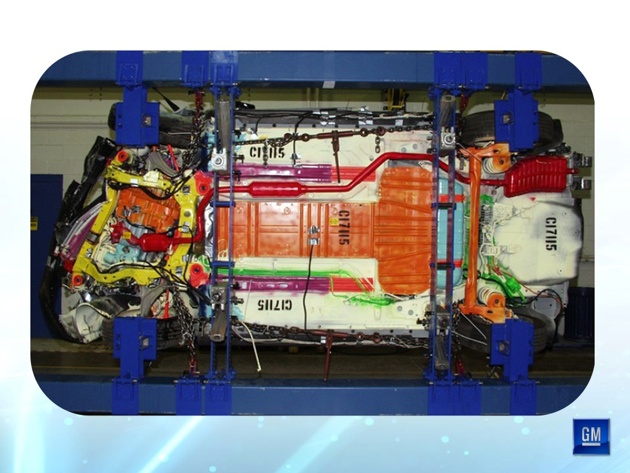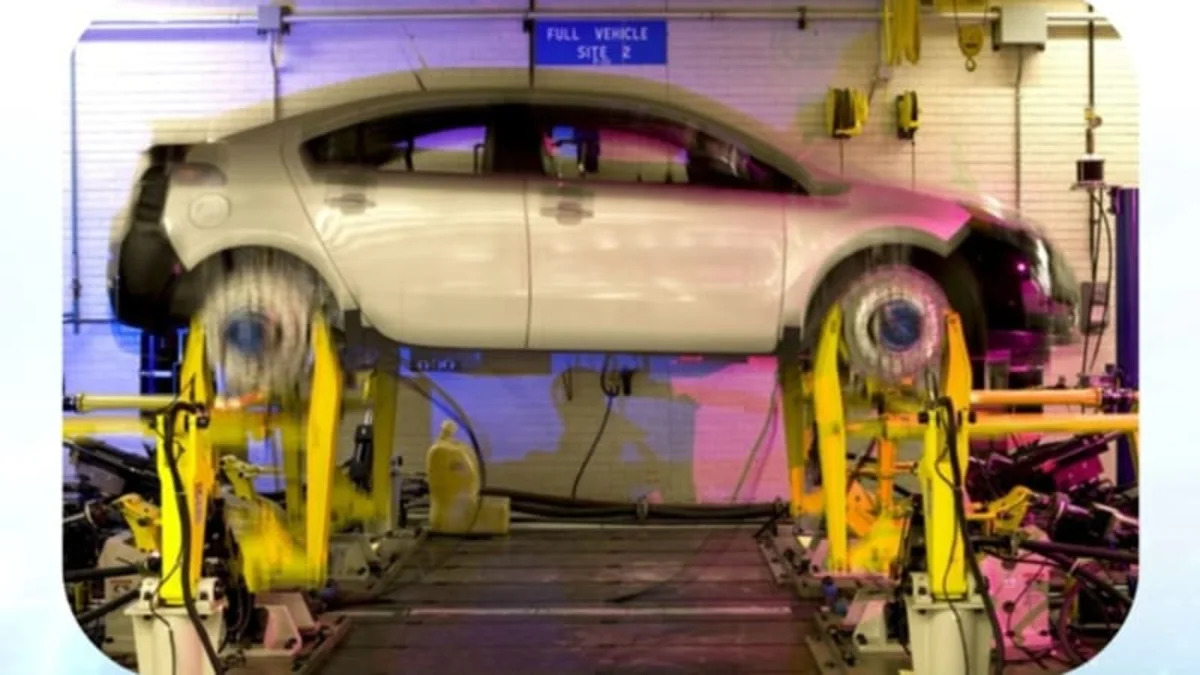Chevy Volt going through a shake test as part of its durability evaluation - Click above for high-res image gallery
General Motors offered an update this afternoon on the current status of the testing and development of the lithium ion batteries for the Chevy Volt. Chief Engineer Andrew Farah and battery engineering group manager Bill Wallace provided a run down on the work done so far. Since work started in earnest on the production program in early 2007, GM has gone from two initial battery development partners (LG Chem/CPI and A123 Systems/Continental) to selecting LG Chem to supply cells. GM also decided to design and build the battery pack in-house rather than having CPI provide the finished pack.
Through the course of development, the team has learned that the battery management system is the key to extracting the best life and performance out of the battery. However, while the battery is the heart of the Volt, Farah emphasized that the goal was to create a great a great vehicle for customers, not just a battery on wheels. That means a lot of integration work has been necessary to incorporate the pack in the car, and develop the charge and battery management software. Read on after the jump.
[Source: General Motors]
Since the beginning of this year, GM has opened its new battery pack manufacturing plant in Brownstown, Michigan, opened a huge new battery test lab and built 80 pre-production (IVER) Volts. In addition, 300 battery packs based on the production design have been built and are being tested in those 80 pre-production cars, the battery lab and other facilities. The test vehicles are now in their third generation starting with the original engineering development cars that were based on the previous-generation Malibu body, the Cruze-based mules (like the one we drove last spring) and the current IVER units.
The next batch of vehicles are the product and process validation vehicles (PPV) which will be the first to be built at the Detroit-Hamtramck assembly plant. The PPV units will built starting in March 2010 and these will be based on the production hardware specs including the proper light clusters (unlike the IVERs). Finally, between August and November of next year, the manufacturing validation build (MVB) will occur. At that stage, everything will be done with production equipment and tooling and these are the first so-called salable vehicles. Those cars, along with the PPVs, will be used in captured test fleets for a variety of real world evaluations including durability testing. Those IVERs recently completed a 65% calibration ride and, according to Farah, none of the issues seen so far are show-stoppers. Farah and Wallace claim everything is on schedule and moving forward to production one year from now. By the end of December, GM will have completed 300,000 miles on the Volt full vehicle simulator, or about three times the design life of most components.
The first builds of packs at the Brownstown plant will begin in February to supply the PPV builds that start a few weeks later. The first of the GM-designed packs was completed in December of last year. Since the beginning of the program, over 50,000 cells have been built and tested and Wallace claims that there has not been a single cell failure to date in either cell level, module level or pack level evaluations. In the lab, the packs have accumulated over 300,000 miles of simulated customer use testing which involves cycling the batteries through routines based on real world driving and charging use. Over time, the cell chemistry has been tweaked a bit to help meet the battery life requirements without affecting performance. According to Wallace, the pack and cells are now set and will not change before production.
The battery testing involves far more than just charging and discharging. Like other parts of the car, the cells, modules and packs have to go through the full "battery" of abuse and crash testing to ensure they live up to the expectations of what might happen in customer hands and beyond. That includes crush and penetration, thermal and overcharge tests on the cells as well as the packs. Characterization tests are also done on cells in order to determine the tolerance range of performance so that the battery management software can properly estimate the state of charge of the cells and packs.
The pack is also put through crush and impact tests to insure that its structural and seal integrity is maintained. This is especially important since the pack is liquid cooled to help optimize its life and performance. The corrosion testing is also very important because the pack is on the bottom of the car. In order to speed up the testing, salt is applied directly to the pack and then it's put into a heated chamber to see what happens.
The whole car is also put through the same testing procedures as all other conventional cars including rough road, hot and cold and of course crash tests. The central location of the pack under the car has benefits in terms of both weight distribution and safety. A photo of a prototype that was run into a barrier at a 30 degree angle at 40 mph shows no intrusion into the pack area.

Speaking of weight, Wallace confirmed that the final pack weighs about 200 kg (440 pounds) but no one would reveal the weight of the car. Farah did acknowledge that the car is a bit heavier than they would like but it is not affecting the performance targets at this point. The team is evaluating weight reductions that will could be rolled out over time during the lifecycle of the car.
Perhaps the biggest concern, aside from the battery performance and life, is the noise, vibration and harshness when the range extender is running. During the tests, the engineers have worked to minimize the NVH during the charge sustaining mode. That includes developing some new bushings such as switching rubber for hydraulics for mounting the engine/generator. That work is still ongoing and includes calibration work on the engine. Other noise sources that have popped up were aerodynamics, including the full belly pan. Changes have been made to venting for pressure relief. Farah again declined to get specific on the capacity of the fuel tank and said that is one area that is yet to be finalized.
Another issue that the Volt and other EVs will face is cold weather performance. The Volt will have an electric heater along with heated seats during cold weather driving. According to Farah, the heated seats actually provide excellent bang for the buck in terms of energy use. Drivers will be able to use the Volt's controls to pick the desired balance of comfort and electric range. The charging system, including the standard J1772 connector, will also interact with the climate control system to pre-warm the car while it is plugged in to minimize the effect on range once the cord is decoupled.
The Detroit-Hamtramck plant is currently being re-tooled for Volt production and should be ready to go by March for the PPV build. The Volt will be one of the focuses of GM's display at the LA Auto Show next month and we expect to learn more about it at that time. Perhaps we'll even get an announcement about the fate of the Cadillac Converj. Farah called it a great concept and he looks forward to getting to work on it, but declined to say if and when it would be built.



Sign in to post
Please sign in to leave a comment.
Continue